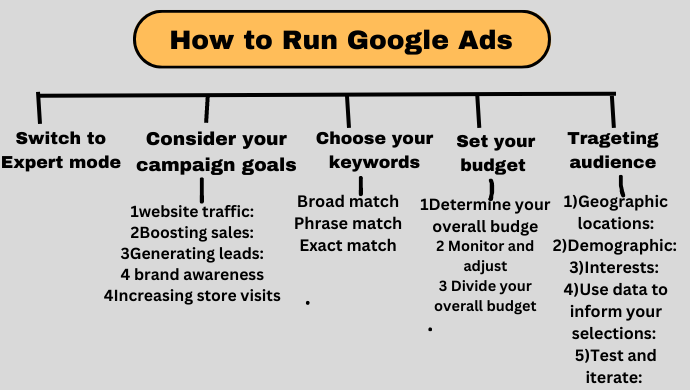Table of Contents
It’s important to note that running a successful Google Ads campaign requires ongoing effort and optimization. You may need to make changes to your ad copy, targeting, or bidding strategy over time to achieve your desired results. Additionally, it’s important to monitor your campaign regularly to ensure that you are not overspending or targeting the wrong audience. By following best practices and continually refining your approach, you can run a successful Google Ads campaign that delivers a strong return on investment for your business
The future of digital marketing is undeniably bright, with businesses increasingly relying on online strategies to connect with their target audience. If you’re eager to embark on a career in this dynamic field, the School of Digital Marketing is your ideal destination. With Digital Marketing courses in Pune, they offer comprehensive digital marketing courses designed to equip you with the latest industry insights and skills. What sets them apart is their commitment to helping students secure job placements through 100% job assistance, as well as their focus on Google certifications.
”We offer a range of courses, from beginner to advanced, that equip students with the skills and knowledge they need to succeed in the industry. Our courses are taught by industry experts and cover everything from SEO and social media marketing to email marketing and conversion optimization. 0B below are some of the cities where you can find classroom training.”
Step #1 Switch to Expert mode
Assuming you are creating a brand new account, your first step will be to visit ads.google.com and click on the “Get started” button. Although Google will recommend setting up a Smart campaign, it is advisable to take the time to create your customized campaigns. Instead of selecting your “Main advertising goal” as prompted, click on the option to “Switch to expert mode.” This will give you more control and flexibility in building out your campaigns, so put on your chef’s hat and start cooking up some custom campaigns that suit your business needs.
Digital marketing jobs are in high demand, as businesses recognize the vital role of online presence in today’s competitive landscape. This trend is driven by the need for skilled professionals who can navigate the dynamic world of digital advertising, SEO, and social media to help companies succeed in the digital age. If you’re eager to embark on a career in this dynamic field, the School of Digital Marketing is your ideal destination. With Digital Marketing courses in Navi Mumbai

Step #2 Consider your campaign goals
Defining campaign goals is a critical first step in running successful Google Ads campaigns. Without clear goals, it’s difficult to know what success looks like or how to measure performance.
Digital marketing salaries vary widely depending on experience, location, and specific roles. Entry-level positions typically start around 1.2 Lakhs to 1.5 Lakhs per year. If you’re eager to embark on a career in this dynamic field, the School of Digital Marketing is your ideal destination. With Digital Marketing courses in Nagpur
Here are a few reasons why defining campaign goals is so important:
here are some common goals that businesses may have when running Google Ads campaigns:
- Increasing website traffic:
This goal is focused on driving more visitors to your website. It can be useful for businesses that want to increase brand awareness, generate leads, or promote a new product or service.
- Boosting sales:
This goal is focused on generating more revenue through your website. It can be useful for businesses that sell products or services online and want to increase sales.
- Generating leads:
This goal is focused on collecting contact information from potential customers. It can be useful for businesses that have a longer sales cycle or want to build a database of potential customers for future marketing efforts.
- Promoting brand awareness:
This goal is focused on getting your brand in front of more people. It can be useful for businesses that are new or want to build a stronger brand identity.
- Increasing store visits:
This goal is focused on getting more people to visit your physical store. It can be useful for businesses that have a physical location and want to drive foot traffic to their store.
- Promoting app installs:
This goal is focused on getting more people to download and use your mobile app. It can be useful for businesses that have a mobile app and want to increase usage.
Step #3 Choose your keywords
- Start with brainstorming:
Begin by brainstorming a list of keywords that are relevant to your business, product or service. Consider what terms people might use to search for what you offer.
- Look for long-tail keywords:
Long-tail keywords are more specific phrases that typically have lower search volumes but can be more targeted and relevant to your audience.
- Check for relevance:
Ensure that your selected keywords are relevant to your business and the products or services you offer. Avoid using broad keywords that are too generic and may attract irrelevant traffic.
- Consider search volume:
Look for keywords that have a high search volume, but keep in mind that high search volume doesn’t necessarily equate to high conversion rates.
- Analyze keyword competition:
Consider the level of competition for your chosen keywords. High-competition keywords may be more expensive to bid on and may not provide a good return on investment.
- Use negative keywords:
Negative keywords are terms you can use to exclude irrelevant search queries. For example, if you sell high-end luxury products, you may want to exclude searches for “discount” or “cheap” to avoid attracting price-conscious shoppers.

Step#4 Create your ads
1)Know your audience:
Before writing your ad, it’s essential to understand your target audience. What are their pain points and needs? What language do they use? Use this information to tailor your ad copy to resonate with your audience.
2)Focus on the benefits:
Highlight the benefits of your product or service rather than its features. Explain how your offering can solve a problem or make your customer’s life easier.
3)Keep it concise:
Use clear and concise language and get to the point quickly. Your ad should be easy to read and understand, so avoid using technical jargon or complicated language.
4)Include a call to action:
Encourage your audience to take action by including a clear call to action (CTA) in your ad. Examples of CTAs include “Buy Now,” “Sign Up Today,” or “Learn More.”
5)Use emotional triggers:
Use emotional language to connect with your audience on a deeper level. Tap into emotions like fear, excitement, or happiness to create a strong emotional response.
6)Highlight unique selling points:
What sets your business apart from the competition? Use your ad copy to highlight your unique selling points and communicate what makes your business different.
7)Test and iterate:
Continuously test and iterate your ad copy to find what resonates best with your audience. Use A/B testing to test different versions of your ad copy and measure their effectiveness.
Step# 5 Set your budget
Explain how to determine a daily budget for your campaign
By following these tips, you can create ad copy that is tailored to your target audience, communicates the benefits of your offering, includes a clear call to action, and stands out from the competition
1)Determine your overall budget:
Start by determining your overall budget for the campaign. How much are you willing to spend for the campaign?
2)Divide your overall budget
by the number of days in the campaign: Once you have determined your overall budget, divide it by the number of days in the campaign to arrive at a daily budget. For example, if you have a budget of $1000 for a 30-day campaign, your daily budget would be $33.33.
3)Consider your campaign goals:
Consider your campaign goals and how they relate to your budget. If your goal is to increase website traffic, you may need to allocate more budget towards clicks. If your goal is to increase conversions, you may need to allocate more budget towards conversions.
4)Look at historical performance:
Review historical performance data from previous campaigns to determine how much budget you need to allocate to achieve your desired results. Look at your cost per click (CPC), cost per acquisition (CPA), and other key metrics to determine an appropriate budget
5)Monitor and adjust:
Once you have set your daily budget, monitor your campaign’s performance regularly and adjust your budget as needed. Increase or decrease your budget based on the performance of your campaign to ensure you are maximizing your return on investment (ROI).
Step#6 Targeting audience
Guide on selecting geographic locations, demographics, and interests to target
Start by selecting the geographic locations you want to target. Consider factors such as where your customers are located, where your products or services are in demand, and where your competition is advertising. Use Google Ads’ location targeting options to target specific regions, cities, or even zip codes.
2)Demographics:
Consider the demographics of your target audience, such as age, gender, and household income. Use Google Ads’ demographic targeting options to reach the right audience.
3)Interests:
Consider the interests and behaviors of your target audience. What are their hobbies and interests? What websites and apps do they use? Use Google Ads’ interest targeting options to reach users who are likely to be interested in your products or services.
4)Use data to inform your selections:
Use data from previous campaigns, website analytics, and market research to inform your selections. Look at your historical performance data to see which locations, demographics, and interests have performed well in the past.
5)Test and iterate:
Continuously test and iterate your targeting options to find what works best for your campaign. Use A/B testing to test different combinations of geographic locations, demographics, and interests to see which ones perform best.
By following these tips, you can select the right geographic locations, demographics, and interests to target, ensuring that your Google Ads campaign reaches the right audience and achieves your campaign goals.
Step#7 Launch the campaign
Once you have set up your campaign, ad groups, targeting options, ad copy, and bids and budgets, launch your campaign. Monitor your campaign performance regularly and make adjustments as needed to optimize your ROI.





